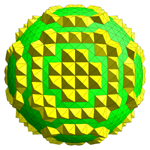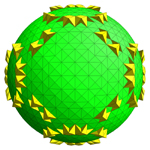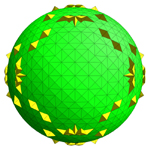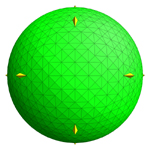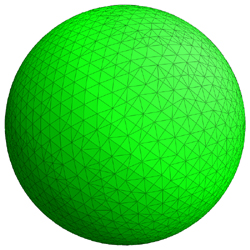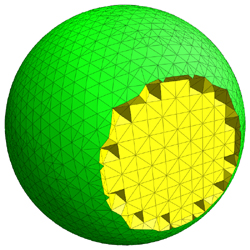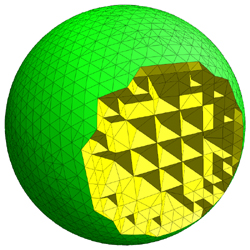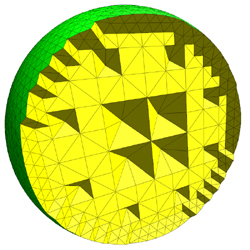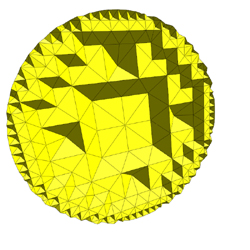3-D Tetrahedral Mesh Generator for Complex
Surfaces
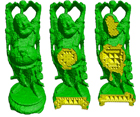 |
Course: Math 285J - Scientific
Computing for the Visual Effects Industry
Quarter: Fall 2007
Professor: Joseph Teran
Final Report
C++ code available upon request (matt.gong@gmail.com) |
Course Description
The visual effects industry has been working for decades to
develop technology that allows filmmakers to generate scenes that would be too
dangerous, too expensive or impossible to create in real life. As time goes by
the bar is being set increasingly high for the realism and complexity of such
effects. One of the most challenging aspects of modern special effects is
reliably reproducing the dynamics of natural phenomena such as crashing waves,
smoke and fire filled explosions, swaying and colliding cloth and hair on
virtual creatures as well as the interactions between these different types of
phenomena. This type of dynamic behavior is very difficult to realistically
reproduce without considering the underlying physical equations of motion.
Though the effects industry is only concerned with generating visually plausible
(as opposed to physically accurate) motion and as such it is tempting to
consider a more simplified approach to creating the effect, it turns out that
ignoring the physical equations results in motions that appear wrong and
synthetic to the viewer. Fortunately, applied mathematicians and physicists have
worked for centuries to derive equations that describe the motion of these
natural phenomena. With modern scientific computing, we can solve these
equations even in the presence of complex three dimensional geometric scenes.
This course gives a practical introduction to the use of numerical simulation
for animating such phenomena. Topics covered will include the modeling and
dynamics of particle systems and rigid bodies ( e.g. stacking and falling
objects in explosions/fracture), review of basic numerical methods for relevant
differential equations, simulation of deformable surfaces and volumes ( e.g.
cloth, skin, hair and flesh), collision detection, modeling energy functions and
hard constraints and CFD for smoke, fire and water.
Project Overview
The goal of this project was to
implement the
Isosurface Stuffing Algorithm which constructs a 3-D tetrahedral mesh from a
given surface. A tetrahedron is like a pyramid, except with a triangular
base (i.e. polyhedron composed of four triangular faces).
The algorithm is fast and provides three
mathematical guarantees: the tetrahedra have good dihedral angles, the boundary
of the mesh is close to the surface, and provided the surface is a smooth
manifold with bounded curvature and the mesh resolution is fine enough, the mesh
boundary is homeomorphic to the zero-surface. These mathematical
properties make the generated meshes suitable for physical simulation that
undergo large deformations (e.g. fluids).
The algorithm comes in two parts: one
that builds a mesh of uniform-sized tetrahedra and another that extends this
algorithm by “grading” the tetrahedra, creating larger tetrahedra in the center
of the mesh while keeping the surface resolution fine and uniform. This
project implements both parts of the algorithm in C++ and OpenGL.
References
1.
Labelle, F.,
Shewchuk, J., “Isosurface Stuffing: Fast Tetrahedral Meshes with Good Dihedral
Angles”,
ACM Transactions on Graphics,
26
(3),
2007.
|
Uniform Tetrahedra Algorithm
|
|
The algorithm takes as input a surface defined by a level
set of a signed distance function. In other words, we use a function
that maps a 3D point in space to a signed distance to its closest point on
the surface (positive inside the surface, negative outside the surface, and
zero on the surface). In this sense, the surface is called an
isosurface since it is defined by all the 3D points that return a
constant value, namely 0. An interesting
observation is that the closest point from any point to the surface is
always in the direction perpendicular to the surface.
Shown is a sphere level set, the easiest surface to
test with since it is conveniently defined as a constant distance from its
center. |

(click image to enlarge) |
|
A body centered cubic (BCC)
lattice is constructed about the surface. This special lattice
structure produces tetrahedra with desirable angles and edge lengths.
It is essentially two point grids - a Cartesian grid and a half-shifted Cartesian
grid - connected by diagonals that adjoin pairs of adjacent horizontal and
vertical grid edges.
The algorithm first selects a subset
of lattice vertices that are either inside the surface or are connected by
an edge to a vertex in the surface.
Next, iterative
bisection is used to compute approximate intersection points (called "cut"
points) where edges intersect the surface (shown in green). In the
event that a cut point is too close to a lattice point, the lattice point is
warped to the cut point and the cut point is discarded. The paper
contains a table with different distance percentages for determining if a
cut point is “too close” to a lattice point. Each distance percentage
is useful for specific angle guarantees of the output mesh (such as minimum
dihedral angle, max exposed plane angle, etc.). I chose the
percentages to guarantee a good dihedral angle lower bound. |
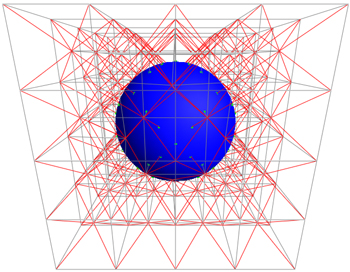
(click image to enlarge) |
|
Shown are all the BCC tetrahedra
that are either completely or partially inside the surface. A BCC
tetrahedra is constructed from a horizontal edge from one grid, a vertical
edge from the other grid, and the diagonals that adjoin them.
The yellow triangle faces are those
partially inside/outside the surface and the green triangle faces are those
on the surface (due to the warping from the previous step). Note the
resolution of this grid is coarse for illustrative purposes. |
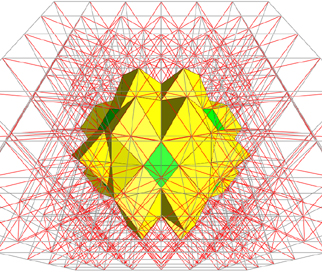
(click image to enlarge) |
The result is a tetrahedral mesh completely filled with uniform sized
tetrahedra. The right shows a cutaway view of this mesh.
This mesh would not be suitable for physical simulation
as it would be wasteful to process every small triangle in the center of the
mesh.
The next part of the algorithm is an improvement to
create larger tetrahedra in the center where detail is less critical.
|
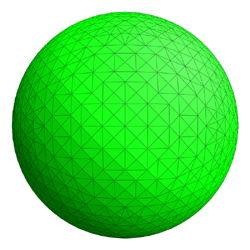 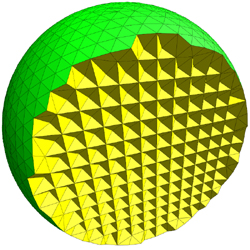
(click image to enlarge) |
|
Graded Tetrahedra Algorithm
|
|
The algorithm takes as
input the approximate width of tetrahedra in the output mesh, which
translates to the width of surface cubes. Starting from a cube
known to be on the surface, we use depth first search over the space of
cubes to find all cubes that intersect the surface. We use a hash
table of cubes keyed on their 3D coordinates to optimize the search.
Additional cubes are
added to this set according to the
Continuation Condition. This will add cubes that are adjacent to
cube faces and corner vertices that intersect the surface, guaranteeing that
only BCC tetrahedra will intersect the surface. |
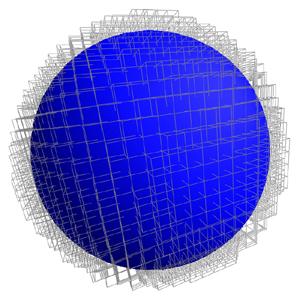
(click image to enlarge) |
Next we build an octree from the surface cubes. An octree is a
commonly used tree structure in graphics where 3D space is partitioned by continuously
subdividing an octant (cube) into eight child octants.
The octree is constructed from the surface cubes
which become the leaf octants of the tree, and their ancestors (shown in magenta). The octree
is kept sparse by allowing a parent octant to have any subset of its eight
children. |
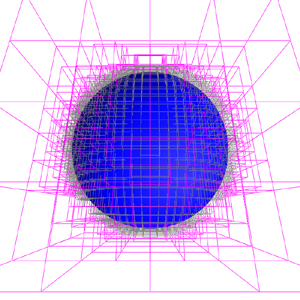
(click image to enlarge) |
In order to
keep high element quality of the mesh, we enforce the Weak Balance
Condition. This will create more octants in the tree where
a pair of parent/child octants or adjacent octants differ in size by more
than a factor of two. |
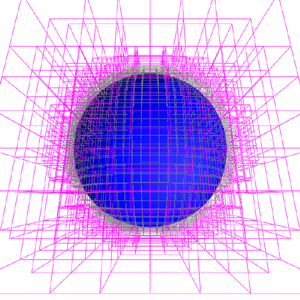
(click image to enlarge) |
|
We convert the balanced octree to a
background grid, shown to the right. This grid is comprised of
BCC tetrahedra and three new types of tetrahedra: bisected BCC tetrahedra,
quadrisected BCC tetrahedra, and half pyramid tetrahedra. These new types
support the bridging of octants that differ by a factor of two.
The primary goal is to ensure that only
BCC tetrahedra intersect the surface so they can be stuffed by the stencils
from the uniform algorithm. |
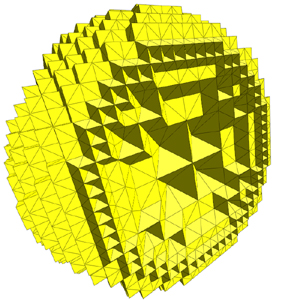
(click image to enlarge) |
|
Shown is another example mesh (with cutaway views) using
a level set function that defines a Buddha surface. The mesh
was generated in 4.603 seconds and contains 167,237 tetrahedra, with surface
tetrahedra size roughly at 1% of the total surface size.
All meshes were generated on a Sony Vaio laptop with a 2.0 GHZ Intel Core 2
Duo (T7200). |
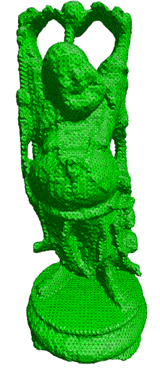 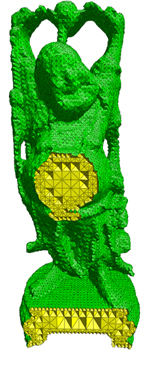  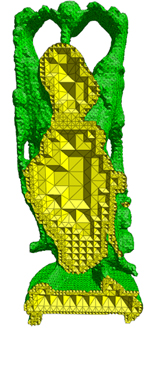 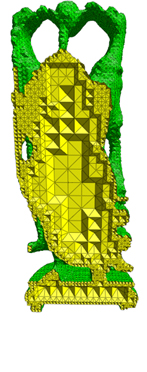
(click image to enlarge) |
Shown are close up views of the Buddha's
head at different mesh resolutions. Note the mesh was only generated
for the visible region. First mesh generated in
710 milliseconds, contains 27,950 tetrahedra, with tetrahedra size at 6.7%.
Second mesh generated 4.186 seconds, contains 143,879 tetrahedra, with
tetrahedra size at 3.3%
Third mesh generated in 39.481 seconds, contains 901,177 tetrahedra, with
tetrahedra size at 1.24%
Fourth mesh generated in 131.029 seconds, contains 3,604,085 tetrahedra,
with tetrahedra size at 0.53% |
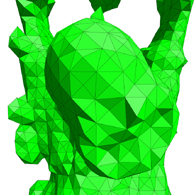 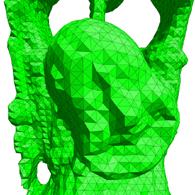 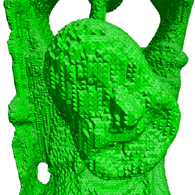 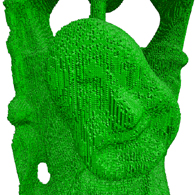
(click image to enlarge) |




